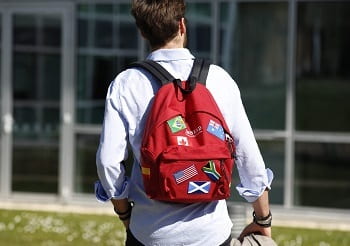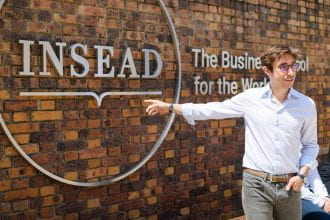INSEAD attracts and enhances ‘Global Cosmopolitans’ who make a world of difference
The outward signs of global professionals are easy to discern: bleary-eyed sky warriors balancing an airport espresso while lugging Tumi bags through the Arrivals concourse en route to the taxi; battling to connect to local WiFi after traversing eight time zones.
The inner life of managerial Magellans, though, reveals a mix of influences and skills that cannot be represented with a passport stamp. These are “Global Cosmopolitans” (GC), in the words of INSEAD Emeritus Professor Linda Brimm, who has studied the “complex experiential learning journey” of these highly educated, multilingual businesspeople who have lived, worked and studied in different cultures. Her 2010 book, Global Cosmopolitans: The Creative Edge of Difference, explores the traits, strengths and challenges associated with these citizens of the world.
“These are people with in-depth knowledge of more than one culture and language,” says Professor Brimm, an organisational behaviour expert and clinical psychoanalyst. “They also demonstrate cognitive flexibility and can shift perspectives to adopt ‘insider/outsider’ views of a situation.”
With its unique multicampus structure and global curriculum, INSEAD has long attracted and developed the people Brimm describes. The school’s diverse student body comes from more than 80 nations, and many of these individuals have even more richly complex identities because of their experiences.
Majken Bønnelykke, MBA’14D, is an excellent example. She was born and raised in a bilingual home in Denmark until age 19. Because her father is Danish and her mother Singaporean/Malaysian-Chinese, the family took frequent “holiday adventures” around the globe to visit relatives. When the family moved to Sydney in 2001, she went to university there and earned a dual-degree in business administration and psychology along with a major in Mandarin. During her studies, she travelled repeatedly to China to learn and work in Beijing, spending a total of eight months there. After graduation, she joined Accenture’s Sydney offices and soon was working on a global project based in Singapore, a stay that ended up lasting five years, after which she moved to France and enrolled at INSEAD. She says INSEAD was critical to her “cultural identity sense-making” capabilities, opening her eyes to “a new vocabulary about her cultural identity” that is vitally important for her in both personal and organisational settings.
“Even before I left Denmark, though, I was ‘culturally curious,’” says Majken, who recently came “full circle” and returned to her homeland to join The LEGO Group as Director of Executive Strategy and Agenda. “From an early age, I sought international experiences: language courses in Germany, exchange programmes in Sicily, summer camps in New York, sailing regattas in Italy and Holland. This curiosity has been the foundation fuelling my seeking new adventures.” Such global experiences, she adds, are typical of INSEAD students.
Wouter Wynberg’s global journey shares some similarities to Majken’s. A commercial analyst for Qantas Airways, Wouter, MBA’12D, is based today in Sydney, but the route he took to get there reveals a pattern not uncommon among GCs. He is the child of bilingual parents who spoke Dutch and English and who grew up in South Africa. The family lived in the Netherlands until Wouter was eight, and then moved to Western Australia where he attended the local school and was steeped in English and the local culture. Four years later, he returned to the Netherlands only to move to Edinburgh, Scotland from age 15-18, followed by a move to Durham, England (18-21) and then Singapore (21-25). When he attended INSEAD, he spent time both in Singapore and France, and since then he has been in Sydney, itself a multicultural city, not unlike Singapore, says Wouter.
“You automatically pick and choose elements from this mix of cultural exposure and then form your own unique blend,” he says, adding that many of his INSEAD colleagues chose the school because it “welcomes this cosmopolitan background as a asset, rather than as a risk, and lets you build on this foundation instead of having to try to learn it from scratch in the classroom setting.”
That’s critical, because while the classroom—especially one as diverse as INSEAD’s—can enhance one’s global perspectives, it is not a substitute for the “lived experiences” that Professor Brimm says contributes to GC’s ability to “reinvent themselves and experiment with new identities in new settings.” This reinvention is a double-edged sword, she cautions. When moving to a new culture, there can be “a loss of what you think that you know, as well as your friends and your established way of doing things.”
This consideration rings true for Majken. Spending 13 years adapting to new cultures, she says, meant “constantly questioning” her frame of reference. “Sometimes I felt like I had to leave a little bit of my old self behind to grow a ‘new part’ that suited my new surroundings,” she reflects. “This was uncomfortable at times, but it taught me how to ‘absorb’ change. I think it’s the essence of adapting. Over time, it becomes second nature.”
Fortunately, technology and extended communities like INSEAD’s alumni network can mitigate such challenges. When people leave home to live or work elsewhere, they can more easily retain connections with friends and family even a world away, thanks to digital tools. Practising this “intimacy at a distance” can even nurture new strengths and fresh ways of thinking.
In fact, global perspectives can enhance creativity, says Associate Professor of Organisational Behaviour William Maddux. His research examines the psychology of how different cultural experiences affect creativity. “Individuals who have lived or worked abroad are better able to solve psychological tests of creativity than those without such experiences,” he says. “They are better able to generate brand new insights and they can make novel connections among very different ideas.” The reasons why may have to do with how these experiences fundamentally “change individuals’ cognitive flexibility” and foster more nuanced perspectives.
Professor Maddux says that this creativity can extend from individuals to institutions. His work with INSEAD Professors Frederic Godart and Andrew Shipilov reveals that the world’s best fashion houses produce “more creative designs” when their creative directors have more experience working abroad.
Creativity and international experience seem linked also because Global Cosmopolitans regard change as normal, positive and a source of opportunity, rather than an impediment. As outsiders to any one set of fixed cultural rules, explains Brimm, “they rely on creative thinking and adaptation to confront new situations.” She says GCs often see the connectedness of the world’s problems and opportunities. They also understand the impact of creating teams that transcend national boundaries.
Executive recruiter Alexandre Sabbag MBA’94D is an expert at spotting top global talent. A Partner in the São Paulo offices of Boyden, a multicultural search firm with more than 70 offices worldwide, Alexandre says there are three core characteristics he looks for in global leaders: curiosity, empathy and flexibility. “A true global professional must thoroughly understand the context through a genuine curious approach that values the culture of others,” he explains. More than that, the person should understand “the human dimension and impacts” of the local setting, demonstrating empathy and the ability to adjust to different environments.
A Brazil native, Alexandre attended an international school and participated in cultural exchanges in his youth, experiences that he credits with broadening his perspectives. While Global Cosmopolitans begin developing their capabilities early, these people find at INSEAD an environment that further nurtures and challenges them. Authentic student diversity is one element in the school’s ability to sharpen talent prepared to manage organisations anywhere in the world.
INSEAD helped Alexandre discover a deeper understanding of the world by exposing him to many cultures. “I confess, I used to see more ‘blacks and whites’ rather than ‘grey zones’ before my MBA studies,” he says. “INSEAD group work was outstanding in helping me adjust my cultural mindset to see many new ‘tones of grey’ and to more profoundly understand other people’s viewpoints.”
Similarly, Wouter says that working in diverse teams at INSEAD helped him understand different communications styles and expertise. “Diversity can be ‘invisible,’ at times, especially when both parties speak the same language,” he says. Being aware of deeper differences, though, can help teams identify and “translate” ideas that could otherwise be misunderstood or even lost.
Such talents can translate into greater career opportunities, too, says Maddux, citing a recent longitudinal study of INSEAD MBAs. “Our results showed that the more they learned about and adapted to the new cultures they encountered during their 10 months on campus, the more job offers they received by graduation,” he notes.
It’s not hard to understand why. At INSEAD, students and faculty constantly think about business education in a global context, Maddux says. “Probably the most common question we get in the classroom is, ‘How would this concept work in Argentina, India, Thailand or Nigeria?’”
For INSEAD alums like Majken, the question is at the heart of her professional life. True global professionals, she believes, move effortlessly between cultures and countries. “To me, LEGO represents the essence of ‘Danish-ness,’ both in its company and product philosophy,” she says. “Yet, it is an international company with presence in more than 40 countries, and it’s on a mission to becoming truly global.”
INSEAD helped Majken develop the skills to thrive in this borderless world, she says. But it did more, too: “The school also provided me with an enormous sense of forward momentum coupled with high hopes and expectations of life.”
Read more about Professor Linda Brimm’s work on Global Cosmopolitans.




